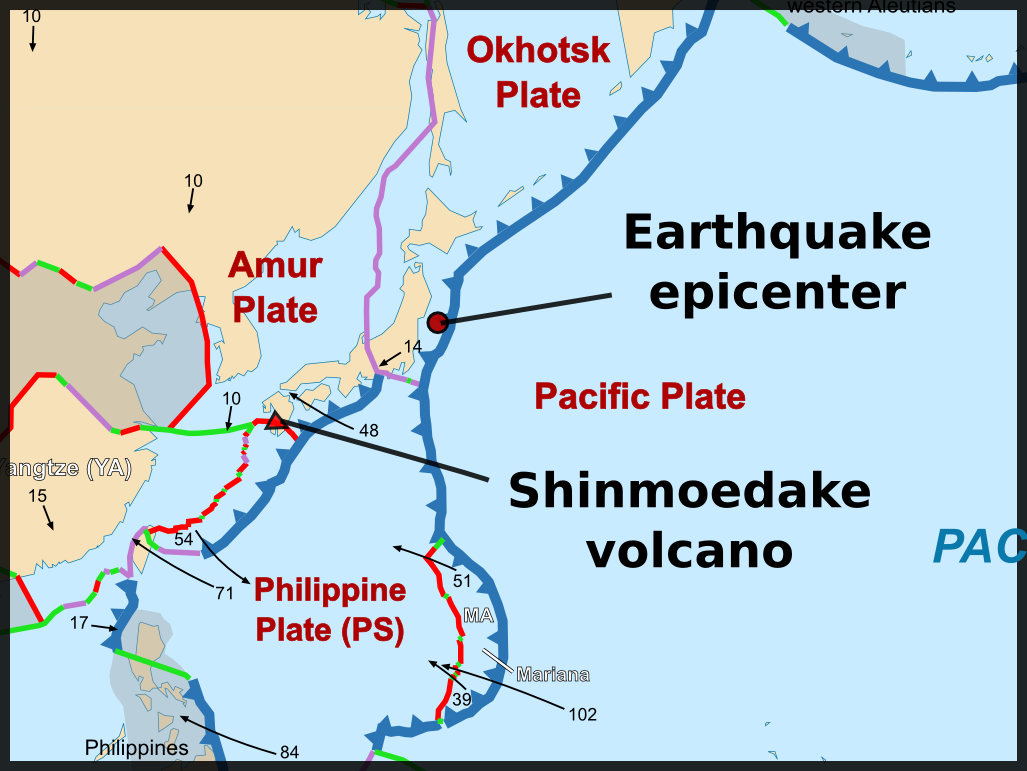-
Chapter 5: NATURAL CALAMITIES
Earthquakes
Sudden movement or vibration in Earth crusts. It is due to release of energy and active internal dynamism of the earth.
Types:
1. Shallow focus
2. Intermediate focus
3. Deep focus
Shallow focuses are the most destructive.

Fig 1: Japan has frequent earthquakes as it’s located at junction of three plates.
Reasons:
1. Collision of plate boundaries like Ocean – Ocean, Ocean – Continental or Continent – Continent plates.
2. Divergent plate boundaries lead to earthquakes due to formation of mid ocean ridge and eruptions.
3. Transverse plate boundaries create friction of plates and lead to earthquakes.
4. Breaking of plates and frequent interaction between them.
5. Human induced due to Mining, building of dams.
6. Re emergence of old fractures.
Tsunami
The tsunami waves are created due to the energy released from plate collision. The colliding energy is transmitted to the waves. These waves have greater wavelength and height when they hit the coast.
The vessels in the ocean don’t feel the tsunami. Waves also have higher speed.
Floods
Floods - Inundation of land. Indian climate where monsoon concentrated in a few months leads to flooding situation. The reasons of a flood are heavy rainfall, poor drainage due to topography, cloud burst, siltation of river bed, landslide in course of river.
Human induced reasons like deforestation, unplanned settlements, global warming and melting of glaciers and construction of dams.
Solution:
1. Afforestation on river banks
2. Better settlement management
3. Watershed management and rainwater harvesting
Droughts
Rainfall is 60 - 75 cm then place is considered as drought affected. Southern part of Deccan plateau, Western Rajasthan and Ladakh are considered drought prone as these have 25% variability of normal rainfall.
In India drought is a more complex problem. Drought is due to inadequate development. It leads to agrarian poverty, high mortality of infants and mothers.
To resolve drought related problems:
1. Improve agriculture irrigation facility
2. Provide alternative livelihood
3. Economic status of farmers.
Rain fed areas where agriculture completely depends on rainfall cover 55% of the country. 50% of food grains, 90% of pulses / millets and 66% of livestock population resides here. However, there is low productivity, high poverty and subsistence farming. 40% of India's B.P.L population live here.
The following are drought prone areas:
1. Rain shadow region of western Ghats – don’t receive adequate rainfall
2. Malwa, Bundelkhand, Mewar
3. Eastern India – high rainfall but overuse and inadequate storage
4. North east India – wettest part of India but no availability of storage.
Solution:
1. Agricultural income should be supplemented by alternate income sources too from animal husbandry, food processing, agro-forestry, handicrafts and tourism.
2. For availability of alternate income 24*7 electricity, transportation, connectivity should be ensured.
3. Mostly cash crops are grown in rain fed areas and this should be changed to less water intensive crops like millets. Agro practices should be changed like use of drip irrigation, sprinkler irrigation.
4. Use of Drought-resistance variety, Conservation of soil moisture – mulching, Pre-monsoon ploughing and soil dressing ,Deep drilling of seed and fertilizers , crop-rotation.
Chapter Review
Score more than 80% marks and move ahead else stay back and read again!